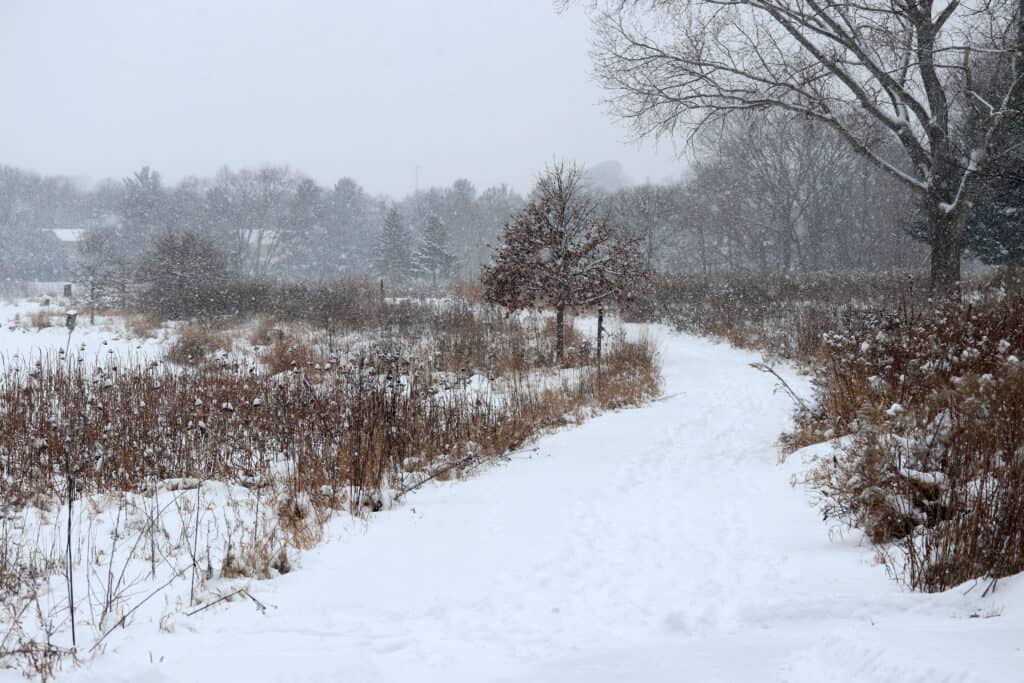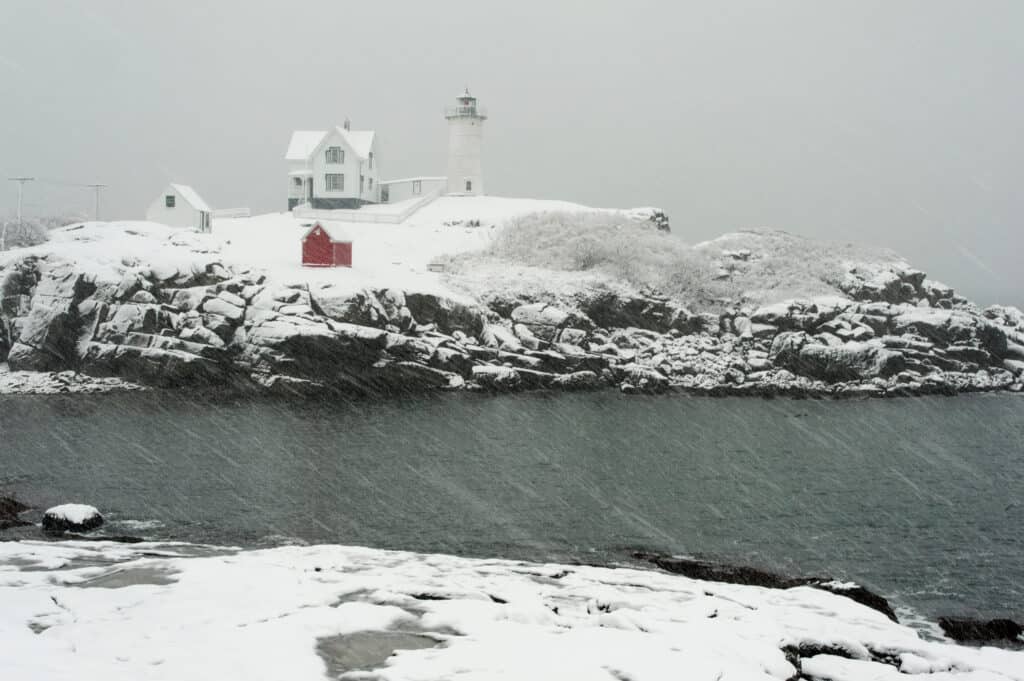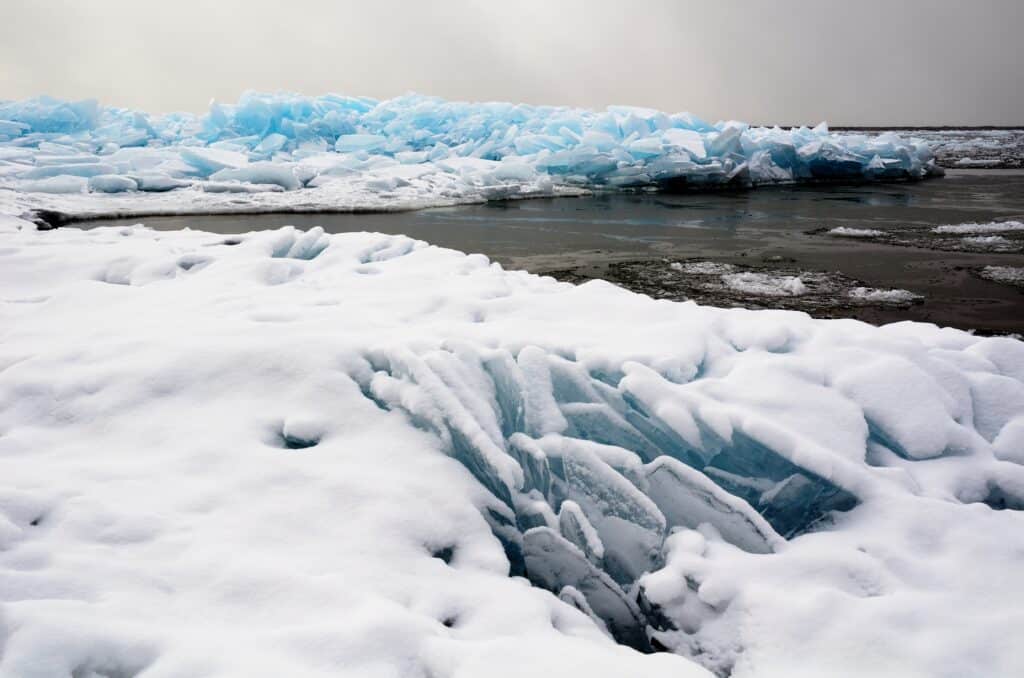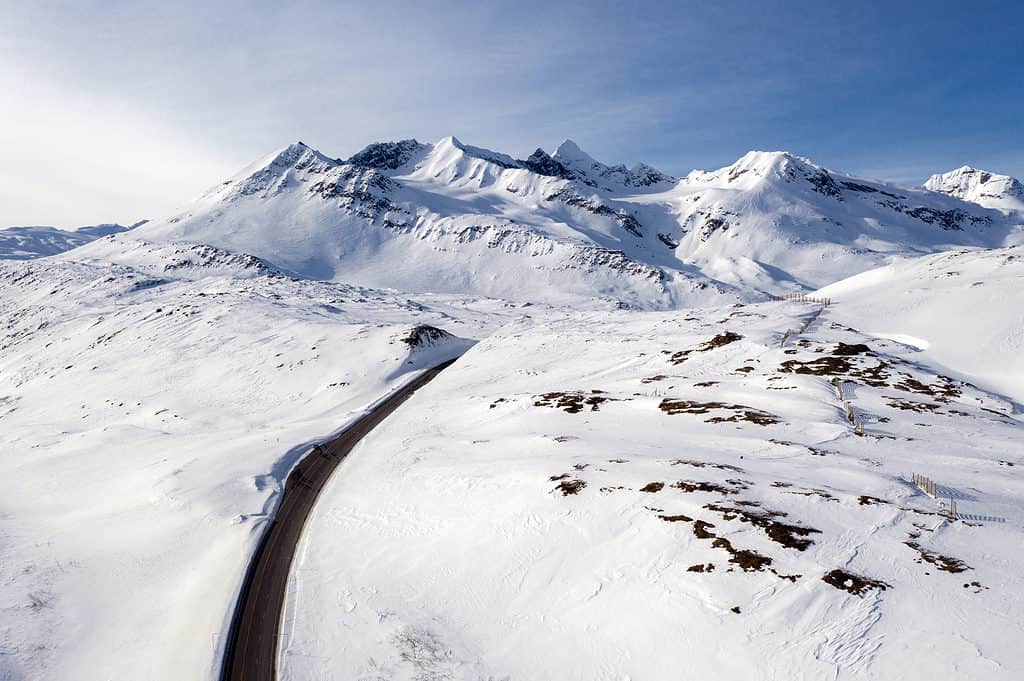Winter in the United States reaches freezing temperatures, and January is the season’s peak when temperatures get the coldest. With 50 states, not all of the regions in the U.S. get freezing, and some can actually be quite warm. January in the coldest states reaches bone-chilling temperatures, and weather like blizzards, and hail storms are common. Let’s take a look at the 7 coldest states in January and the low temperatures these regions reach.
This list uses states’ average temperatures in January from the NOAA, and what states have been the coldest in the month for over the last 30 years. The United States climate varies, and you can find many places that either get extremely hot, or cold. States in the north tend to get colder since they are further away from the equator. Here are 7 of the coldest states that reach freezing temperatures in January.
1. South Dakota
| South Dakota | ||
|---|---|---|
| Population(2022 est.) | January Avg. Low | January Avg. High |
| 909,000 | 28.6°F(-1.8°C) | 8.2°F(-13.2°C) |
South Dakota is one of the coldest states in January, and it is also very snowy, with an average of 30 inches falling annually in most of the state. The climate in the state fluctuates greatly from hot summers to freezing winters. The coldest temperature ever recorded was in 1936 when it reached -58 degrees in McIntosh. The temperatures vary across the state with the northeastern regions being the coldest.
With its low population size, South Dakota is one of the least populated states but is abundant with wildlife. You can find habitats like lakes, mountains, and grasslands. When not freezing over South Dakota has animals active like mountain lions, prairie dogs, deer, goats, beavers, turkeys, and squirrels.

South Dakota
is one of the coldest states in January, and it is also very snowy, with an average of 30 inches falling annually in most of the state.
©Jacob Boomsma/Shutterstock.com
2. Vermont
| Vermont | ||
|---|---|---|
| Population(2022 est.) | January Avg. Low | January Avg. High |
| 647,000 | 26.8°F(-2.8°C) | 7.9°F(-13.3°C) |
In the U.S., Vermont is considered one of the coldest states, reaching its lowest temperatures in January. Snow is extremely common in Vermont, and it is considered the snowiest state in the U.S. You can expect an average of 89 inches of snowfall yearly, with the state snowing for around 54 days of the year. Vermont in the past has reached extremely cold temperatures, with the coldest temperature ever recorded being -50 degrees in the winter of 1933.
Before the cold Vermont winter reaches its lowest temperatures many of the native animals migrate to warmer areas or hibernate to wait out the cold. There are around 260 bird species in Vermont, many of which are migratory. Animals like wolves, rabbits, moose, beavers, bobcats, and black bears are some of the animals active in the state when temperatures are not freezing.

Snow is extremely common in Vermont, and it is considered the
snowiest state
in the U.S.
©iStock.com/George Robinson
3. Wisconsin
| Wisconsin | ||
|---|---|---|
| Population(2022 est.) | January Avg. Low | January Avg. High |
| 5,893,718 | 23.8°F(-4.5°C) | 6.7°F(-14.05°C) |
Wisconsin is one of the many cold states in the freezing January winter. Temperatures can get as cold as -40°F, and are even lower in the coldest regions, with the record cold in Wisconsin reaching -55 degrees. Yearly the state gets an average of 40 to 50 inches of snowfall, but up to 100 inches in the snow belt portion of the state. While summers in the state are relatively cool, the record high temperature in Wisconsin still managed to reach a high of 114°F in the summer of 1936. The badger is the state animal in Wisconsin, and it is just one of the 668 vertebrates native to the area. When not frozen over Wisconsin grasslands, deserts, mountains, and aquatic habitats flourish.

Temperatures can get as cold as -40°F, and are even lower in the coldest regions, with the record cold in Wisconsin reaching -55 degrees.
©MarynaG/Shutterstock.com
4. Maine
| Maine | ||
|---|---|---|
| Population(2022 est.) | January Avg. Low | January Avg. High |
| 1,285,340 | 24.7°F(-4.05°C) | 5.7°F(-14.6°C) |
Maine is one of the coldest states in January, and in winter has an average temperature that ranges from 25°F (-3.8°C) in the far south, and reaches temperatures lower than 15°F (-9.4°C) in the northern and interior regions of the state. Maine is the second snowiest state in the U.S. It averages between 50 to 110 snowfall yearly, with the coastal regions being the snowiest.
Known for its gorgeous coastline, Maine has a sea line that stretches around 3,500 miles. The state obtains the most lobsters than any other place in the U.S., harvesting over 100 million lbs of lobster yearly. Maine is abundant with wildlife, bears, moose, and deer, making it a fun stop for enjoying nature.

Maine is the second snowiest state in the U.S. It averages between 50 to 110 snowfall yearly, with the coastal regions being the snowiest.
©Allan Wood Photography/Shutterstock.com
5. Minnesota
| Minnesota | ||
|---|---|---|
| Population(2022 est.) | January Avg. Low | January Avg. High |
| 5,717,184 | 19.2°F(-7.1°C) | 0.9°F(-17.27°C) |
Minnesota is one of the eight Great Lakes states and is also one of the coldest places in January. Minnesota’s winter is known for its cold, and freezing climate. Snow storms, sleet, and rain are common during the cold season, but the amount of snowfall varies. The state averages around 36 inches of snow in the southwest region of Minnesota, and gets up to 70 inches of snow in the Lake Superior snow belt.
With a size of 86,943 square miles, Minnesota is the 12th largest state. The state has a diverse range of habitats like rivers, wetlands, woodlands, and lakes. Minnesota has the second-highest number of natural lakes in the U.S., with over 14,380 natural lakes residing in the state. The state also has access to Lake Superior, which is the largest natural lake in the U.S.

Minnesota is one of the eight Great Lakes states and is also one of the coldest
places in January.
©Mark Herreid/Shutterstock.com
6. North Dakota
| North Dakota | ||
|---|---|---|
| Population(2022 est.) | January Avg. High | January Avg. Low |
| 779,261 | 19°F(-7.2°C) | 1°F(-17.22°C) |
In the lower 48 states of the U.S., North Dakota is the coldest state and keeps its cold temperature in January, winter’s peak. You can expect an average yearly snowfall in North Dakota of around 39 inches per year. The state has more than 50 days in the year where temperatures do not get higher than zero degrees.
Grand Forks is considered the coldest city in the state, making it one of the coldest areas in the entire U.S. The coldest temperature ever recorded in North Dakota is -60 °F (-51.11°C), within the city of Parshall. The hottest ever recorded was a blistering 121°F, in the city of Steele in 1936.
Even with its cold temperatures North Dakota sustains wilderness like woodlands, badlands, wetlands, prairies, and riparian-type habitats. There are around 87 mammals like shrews, moose, foxes, cougars, and bears that live in the state. 3 national parks are located in North Dakota, helping preserve the amazing nature it houses.

In the lower 48 states of the U.S.,
North Dakota
is the coldest state and keeps its cold temperature in January, winter’s peak.
©FiledIMAGE/Shutterstock.com
7. Alaska
| Alaska | ||
|---|---|---|
| Population(2022 est.) | January Avg. High | January Avg. Low |
| 733,583 | 10°F (-12°C) | -2°F (-18.8°C) |
In the United States Alaska is the largest state, and also the coldest state in January. Having a size of 665,400 square miles, Alaska is filled with forests, tundras, marshes, and rocky coast-type habitats. In the winter Alaska gets freezing cold, and is the fifth snowiest state. It has an average snowfall of about 64.46 inches yearly across the state.
Alaska sits in the corner of North America and is actually closer to Russia than the rest of the United States. Along with being the coldest state in winter, it is also the coldest in summer. Alaska’s cool summer reaches average daily temperatures between 40°F to 60°F (4° – 15°C). Being closer to the North Pole than the rest of the United States, Alaska keeps a cool temperature year-round. The hottest temperature recorded in Alaska is only 100 degrees, measured in Fort Yukon in 1915.
There are over 1,000 vertebrate species that live in the state. Nicknamed the Last Frontier, Alaska’s dense wilderness and low population density across the state is why it has this nickname. Grizzly bears, wolves, moose, wild sheep, polar bears, and hares are just a few of the animals that live on the state’s land. Marine life like orcas, seals, dolphins, and sea otters is what lives near this freezing state’s coast.

In the United States
Alaska
is the largest state, and also the coldest state in January.
©iStock.com/Lance King
Up Next:
- Yellowstone Weather in January: What to Expect
- Discover California’s Coldest January on Record
- 6 Flowers to Plant in January
- Discover The 8 Warmest States in January
The photo featured at the top of this post is © Mild Photo/Shutterstock.com
FAQs (Frequently Asked Questions)
What is the coldest state in January?
Alaska
Which state has the heaviest snowfall?
Vermont
Thank you for reading! Have some feedback for us? Contact the AZ Animals editorial team.






